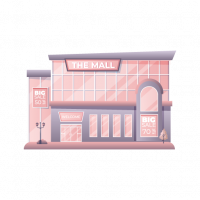Digital Screens | Malls Drive Impulse Purchases | Marketing

In the fast-evolving retail landscape, digital screens have emerged as a powerful tool to influence consumer behavior. Shopping malls, in particular, leverage these dynamic displays to enhance customer engagement and drive impulse purchases. But how exactly do digital screens achieve this? Let’s explore the key ways they impact purchasing decisions and why they are becoming an indispensable part of modern retail marketing.
1. Captivating Visual Appeal
Digital screens are designed to grab attention instantly.
Unlike static posters, they feature bright visuals, motion graphics, and
interactive elements that naturally draw shoppers' eyes. This visual appeal
creates a strong first impression, making it easier for brands to introduce new
products, promotions, and limited-time offers that encourage impulse buying.
2. Real-Time Promotions and Personalized Advertising
One of the biggest advantages of digital screens is their
ability to display real-time promotions and personalized content. Retailers can
update ads instantly to showcase flash sales, discounts, or trending products
based on consumer behavior. By leveraging data analytics, brands can tailor
messages to different demographics, increasing the likelihood of impulse
purchases.
3. Strategic Placement to Influence Buying Decisions
Malls strategically position digital screens in high-traffic
areas such as entrances, escalators, food courts, and checkout counters. These
locations maximize visibility and influence shoppers when they are most
receptive. For instance, a well-placed screen near a food court displaying
mouthwatering images of a dessert can prompt an unplanned purchase.
4. Social Proof and Influencer Endorsements
Consumers are more likely to make impulse purchases when
they see others endorsing a product. Digital screens can display social proof
through customer testimonials, influencer promotions, and user-generated
content. When shoppers see their favorite influencers recommending a product,
they may feel compelled to buy it immediately.
5. Interactive and Engaging Content
Interactive digital screens elevate shopping experiences by
offering touch-based navigation, augmented reality (AR), and gamification. For
example, a fashion retailer might use an interactive screen that allows
customers to try on outfits virtually. This not only enhances engagement but
also increases the likelihood of spontaneous purchases.
6. Emotional Triggers and FOMO (Fear of Missing Out)
Marketing psychology plays a crucial role in impulse buying.
Digital screens can trigger emotions through storytelling, uplifting music, or
urgency-inducing countdown timers. When shoppers see messages like “Only a few
left in stock” or “Sale ends in an hour,” the fear of missing out (FOMO)
compels them to make quick purchasing decisions.
7. Seamless Integration with Mobile and Digital Payments
Many digital screens in malls now integrate with QR codes
and mobile apps, allowing shoppers to scan and purchase instantly. This
seamless connection between in-store advertising and online purchasing removes
friction, making impulse buying more convenient than ever.
Conclusion
Digital screens in malls are revolutionizing the way
retailers engage with consumers. By leveraging eye-catching visuals, real-time
promotions, strategic placement, social proof, interactive features, and
psychological triggers, these screens significantly boost impulse purchases. As
technology continues to evolve, we can expect even more innovative and
personalized digital advertising strategies that enhance the shopping
experience and drive spontaneous buying decisions.
Elyts Advertising and Branding Solutions | www.elyts.in (India) | www.elyts.agency (UAE)






















Leave a Comment